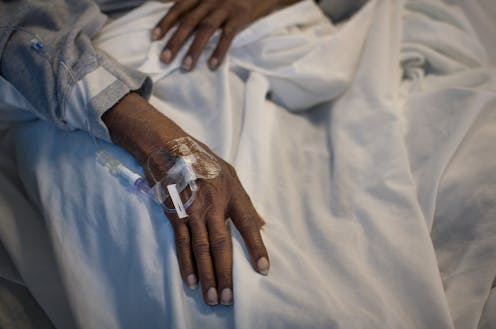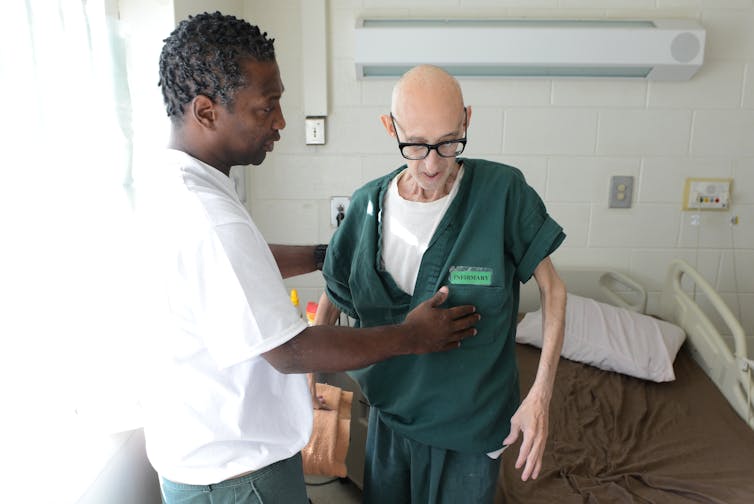More people are dying in American prisons – here's how they face the end of their lives
In the 10 years leading up to 2016, the rate of prisoner mortality rose by 15%. End-of-life options can be limited for inmates.

Outbreaks of coronavirus have hit prison populations particularly hard – but for many inmates in the U.S., illness and the prospect of dying behind bars already existed.
Advocacy groups have flagged concerns about disease transmission, lack of medical care and deaths in custody as a result of COVID-19. But deaths in custody are not a new phenomena and the process of dying with dignity while incarcerated is complicated.
I have spent a significant amount of time examining correctional health care practices and believe the process of dying in prison is one in which human dignity can be lost.
Prisoners grow old faster and become sick earlier. By 2030 some experts believe that one in three prisoners will be over the age of 55, increasing the likely population of prisoners diagnosed with conditions such as cancer, heart disease, liver and kidney disease, high blood pressure and diabetes.
A recent Bureau of Justice Statistics report revealed a startling increase in state prisoner mortality. Between 2006 and 2016, the last year for which the study provided data, there were more than 53,000 deaths in custody. More than half of the 3,739 deaths in custody in 2016 resulted from just two illnesses – cancer (30%) and heart disease (28%).
The proportion of prisoners requiring end-of-life care is twice as high as the general population.

Outside prison walls, a diagnosis of a terminal illness often means gathering friends and family to repair and restore relationships and thinking about end-of-life options. The coronavirus has, of course, affected who can be present in someone’s last moments, but the terminally ill still have options over their medical care, pain management, who to tell and how, and getting affairs in order. For prisoners, such choices are constrained by state regulation. Prisons are not well-equipped to provide human dignity at the end of life. Terminally ill prisoners have two options: compassionate release or end-of-life care behind bars.
Showing compassion
Offering early release or parole to prisoners diagnosed with debilitating, serious and often terminal illnesses is considered compassionate release. Many in the medical profession consider compassionate release a constitutionally protected right as incarceration of prisoners with debilitating illness undermines medical care and human dignity. Others see compassionate release as a way to reduce correctional health care costs for a population posing little risk to the public. Iowa is the only state without a compassionate release law.
The process of qualifying for compassionate release is complex and statistics on how many succeed are hard to obtain, although we know the numbers are small. Prisoners’ medical conditions, age and time served determine eligibility. But exclusion criteria are extensive. For example, prisoners committing the most serious crimes are excluded. Most states allow stakeholders such as victims, police and court professionals an opportunity to say no.
For the terminally ill, release is often dependent on one’s “death clock” – how many months a medical professional certifies that you likely have before dying. In some states like Kansas and Louisiana, death must be imminent – within 30 to 60 days. In others like Massachusetts and Rhode Island, prisoners with as long as 18 months to live may be released. Applying for compassionate release can be daunting for someone with only months to live. Sadly, some die before they can complete the process.
Even if an inmate does get out, their family may be ill-equipped to deal with the challenges of caring for a dying loved one. In these cases, release may result in transition from one restrictive, isolated, institutional setting to another with care provided by unfamiliar medical professionals.
End-of-life sentence
States must provide medical care to prisoners even though they are being punished for a crime. But the quality of such care is often inadequate. The prisoner does not get to select medical options; care is determined by the state. Death could mean dying alone in a prison cell, in an infirmary with only periodic check-ins from a nurse and prison volunteers or in a hospice unit managed by the state.
Pain management may be restricted by correctional policy and by staff who are reluctant to administer narcotics, such as morphine, to ease suffering out of concern that it could be sold or used illicitly. A recent report in the American Society of Clinical Oncology Post discussed how inadequate care caused unnecessary pain and suffering in prison and concluded: “No one in a wealthy and socially advanced country like the United States should suffer from untreated pain, especially at the end of life.”
While families are allowed to visit terminally ill prisoners, notification of the illness rests with the prisoner – a daunting task if the prisoner has lost touch with relatives over years incarcerated. State prisoners are often confined far from home, so even family members who would like to visit may be hampered by distance and cost. Another challenge for families is the bureaucratic process of prison admission. It is correctional staff at the gates rather than medical professionals determining who gets to visit on any given day.
Access to a mainstream faith leaders and last rites are provided when available. But it is not uncommon to find spiritual practices for the dying prisoner carried out by fellow prisoners.
For terminally ill prisoners “getting one’s affairs in order” includes trying to identify someone in the community willing to take responsibility for their body after death and ownership of personal effects gathered during incarceration. Even if the prisoner identifies a relative willing to take responsibility, there are no guarantees. A relative may be disqualified from handling prisoner affairs. In Ohio, for example, if the prisoner’s loved one is unable to accept the body within two days after notification, the relative may be disqualified.
If no one comes forward, then the prisoner will be buried in an indigent grave and prison officials will dispose of the prisoner’s belongings and monies remaining on prisoner accounts.
[You’re smart and curious about the world. So are The Conversation’s authors and editors. You can read us daily by subscribing to our newsletter.]
Martha Hurley does not work for, consult, own shares in or receive funding from any company or organization that would benefit from this article, and has disclosed no relevant affiliations beyond their academic appointment.
Read These Next
What’s at stake in Trump’s executive order aiming to curb state-level AI regulation
In the absence of comprehensive federal AI regulation, states have stepped in. The Trump administration,…
Sleep problems and depression can be a vicious cycle, especially during pregnancy − here’s why it’s
Inadequate sleep can have negative downstream effects on everyday cognitive functioning and mental health,…
Whether Netflix or Paramount buys Warner Bros., entertainment oligopolies are back – bigger and mor
Hollywood has seen this movie before.





